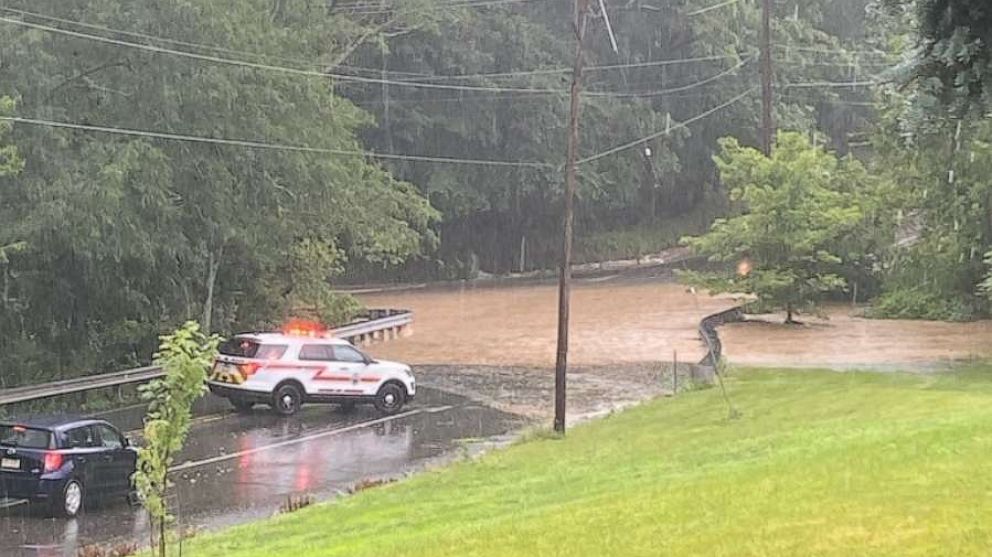Flash Flood Emergency: Protecting Yourself And Your Family

Table of Contents
Understanding Flash Flood Risks
Identifying High-Risk Areas
Flash floods are more common in certain geographical locations. Areas near mountains, canyons, and deserts are particularly vulnerable due to their terrain and rapid runoff. Urban areas with inadequate drainage systems are also at increased risk. Understanding your property's vulnerability is the first step in mitigating the potential damage from a flash flood.
- Examples of high-risk areas: Areas with steep slopes, dry creek beds, and areas with heavy rainfall.
- Websites/resources for checking flood risk: The National Weather Service (NWS), FEMA's Flood Map Service Center, and your local emergency management agency.
- Understanding your property's vulnerability: Check local flood risk maps and consider the history of flooding in your neighborhood. Consult with a flood risk specialist if needed.
Recognizing Warning Signs
Recognizing the warning signs of an impending flash flood is critical. While flash floods can develop very quickly, there are indicators you can watch for.
- Specific signs: Rapidly rising water levels in streams, creeks, and rivers; strong and unusual currents; heavy or prolonged rainfall; a sudden increase in water levels in normally dry areas; unusual weather patterns (intense downpours, hailstorms).
- How to interpret weather alerts: Pay close attention to weather forecasts and warnings issued by the NWS. A flood watch means conditions are favorable for flooding, while a flood warning means flooding is already occurring or is imminent.
- Knowing the difference between a flood watch and a flood warning: A watch is a possibility, a warning is an immediate threat. Act accordingly.
Creating a Flash Flood Emergency Plan
Developing an Evacuation Plan
Having a detailed evacuation plan is paramount. This plan should include multiple escape routes, a designated meeting point outside the flood zone, and regular practice drills.
- Identifying escape routes: Map out at least two different evacuation routes, considering potential road closures due to flooding.
- Designating a safe meeting place: Choose a location outside the flood-prone area where family members can reunite.
- Roles and responsibilities for family members: Assign specific tasks to each member of your household, such as gathering emergency supplies or contacting emergency services.
- Practicing drills: Regularly practice your evacuation plan to ensure everyone knows what to do in case of a flash flood emergency.
Building an Emergency Kit
Preparing a flash flood emergency kit is essential. This kit should contain items to sustain your family for at least 72 hours.
- Detailed list of necessary items: Water (one gallon per person per day), non-perishable food, medications, first-aid kit, flashlights, batteries, a battery-powered radio, blankets, extra clothing, important documents (in waterproof bags), cash.
- How much water and food to store: Aim for a minimum of three days' worth of supplies per person.
- Importance of having waterproof containers: Protect your supplies from potential water damage by storing them in waterproof or water-resistant containers.
Protecting Your Home
Taking steps to protect your home before and during a flash flood can significantly reduce damage.
- Steps for securing your home: Move valuable items to higher ground, install flood barriers (sandbags or commercially available barriers), disconnect electrical appliances, and clear gutters and drains.
- Mitigation techniques: Consider installing sump pumps and elevating electrical systems.
- Insurance considerations: Ensure you have adequate flood insurance coverage. Standard homeowner's insurance policies usually do not cover flood damage.
Responding to a Flash Flood Emergency
Evacuation Procedures
If authorities instruct you to evacuate, do so immediately. Your safety is the top priority.
- Safe driving tips during a flash flood: Avoid driving through flooded areas – even seemingly shallow water can sweep your car away. Turn around, don't drown.
- What to do if trapped in a vehicle: If your vehicle is caught in rising water, get out immediately and seek higher ground.
- Helping others evacuate safely: If possible, assist neighbors, especially the elderly or disabled, in evacuating safely.
Seeking Shelter
If evacuation is impossible, find safe, elevated ground.
- Options for shelter: Go to a designated shelter, a higher floor of your building, or a sturdy structure on higher ground.
- Safe places to take refuge: Avoid basements and low-lying areas.
- Staying informed about weather updates: Keep a battery-powered radio on hand for weather updates.
Post-Flood Safety
After the flood subsides, take precautions to ensure your safety.
- Cleaning up safely: Wear protective clothing and avoid contact with contaminated water.
- Dealing with contaminated water and debris: Properly dispose of damaged items and clean up using appropriate disinfectants.
- Contacting insurance companies: Report flood damage to your insurance company as soon as possible.
- Seeking assistance from relevant authorities: Contact FEMA or other relevant agencies for assistance with recovery efforts.
Conclusion
Preparing for a flash flood emergency requires understanding the risks, creating a comprehensive plan, and knowing how to respond effectively. Remember the key takeaways: identify high-risk areas and warning signs, develop a detailed evacuation and emergency supply plan, protect your home, and follow safety procedures during and after a flash flood. Don't wait for a flash flood emergency to strike. Develop your family's flash flood preparedness plan today. Learn more about flash flood safety and protect your loved ones by visiting resources such as the National Weather Service ([link to NWS website]) and FEMA ([link to FEMA website]).

Featured Posts
-
 Where To Invest A Map Of The Countrys Hottest Business Locations
May 26, 2025
Where To Invest A Map Of The Countrys Hottest Business Locations
May 26, 2025 -
 Ardisson Fustige Baffie Il Vient Cracher Dans La Soupe La Polemique Enfle
May 26, 2025
Ardisson Fustige Baffie Il Vient Cracher Dans La Soupe La Polemique Enfle
May 26, 2025 -
 Thursday Night Viewing Top 10 Tv And Streaming Shows
May 26, 2025
Thursday Night Viewing Top 10 Tv And Streaming Shows
May 26, 2025 -
 Hasil Fp 1 Moto Gp Inggris Marquez Memimpin Motor Mogok Hentikan Aksi Pembalap
May 26, 2025
Hasil Fp 1 Moto Gp Inggris Marquez Memimpin Motor Mogok Hentikan Aksi Pembalap
May 26, 2025 -
 Marc Marquez Di Moto Gp 2025 Analisis Klasemen Dan Peluang Juara
May 26, 2025
Marc Marquez Di Moto Gp 2025 Analisis Klasemen Dan Peluang Juara
May 26, 2025
Latest Posts
-
 Pacers Vs Hawks Injury Report March 8th Whos In And Whos Out
May 28, 2025
Pacers Vs Hawks Injury Report March 8th Whos In And Whos Out
May 28, 2025 -
 John Haliburtons Return To Pacers Lineup After 8 Game Absence Following Bucks Game
May 28, 2025
John Haliburtons Return To Pacers Lineup After 8 Game Absence Following Bucks Game
May 28, 2025 -
 Is Tyrese Haliburton Playing Tonight Latest Injury Report Pacers Vs Nets
May 28, 2025
Is Tyrese Haliburton Playing Tonight Latest Injury Report Pacers Vs Nets
May 28, 2025 -
 Pacers Vs Hawks Injury Report Game Day Update March 8th
May 28, 2025
Pacers Vs Hawks Injury Report Game Day Update March 8th
May 28, 2025 -
 Pacers Haliburton Returns After 8 Game Absence Post Antetokounmpo Battle
May 28, 2025
Pacers Haliburton Returns After 8 Game Absence Post Antetokounmpo Battle
May 28, 2025
